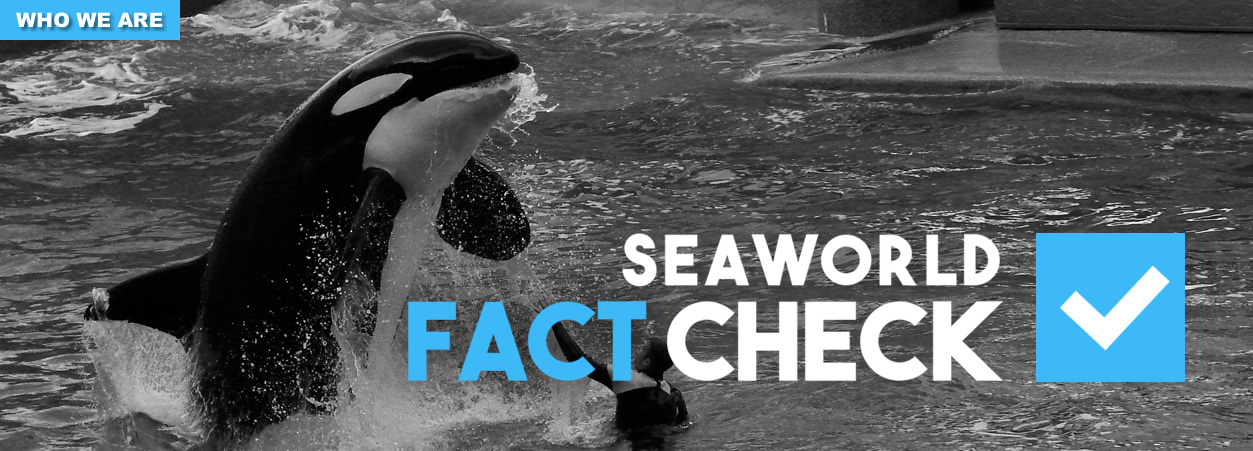SEAWORLD FACT CHECK:
SeaWorld was asked whether or not it still collects whales from the wild. It responded by saying it hasn’t collected a killer whale from the wild in over 35 years.
A consortium of five facilities – Georgia Aquarium in Atlanta, John G. Shedd Aquarium in Chicago, and SeaWorld’s three parks – “collected” (captured) 16 beluga whales in the Sea of Okhotsk, Russia, in 2010 and 2011. The Georgia Aquarium, as the lead facility, applied for a permit to import 18 belugas (two more were added to the 16 – see below), with 11 of them slated to go to the three SeaWorld parks1.
These whales were healthy and free-ranging, not stranded or in any way needing “rescue.” They were deliberately captured in 2010 and 2011 by the Utrish Dolphinarium on the Black Sea (where the whales were shipped for holding, a trip of more than 4000 miles) to sell to the consortium. Two additional belugas, possibly surplus to an order from another customer, were captured by Utrish in 2006 and included in this sale. Rather than wait until a permit to import whales was secured, the consortium paid to conduct some preliminary research to justify the removals and while the research was ongoing, had Utrish capture 16 whales. That is, before determining the sustainability of the removals, the consortium, SeaWorld included, had the animals captured and held by Utrish. Not only did the consortium anticipate the data, but it assumed regardless of the results of its research that the US government would issue the import permit. (Alternatively, the consortium may have meant to influence the decision by capturing the belugas before securing the import permit.)
The import permit was denied because the consortium failed to show how the import complied with the strict sustainability requirements of the Marine Mammal Protection Act. But instead of accepting that in fact the captures were not sustainable (the beluga capture operations in the Sea of Okhotsk are currently under scrutiny by the IWC Scientific Committee and have been deemed unsustainable at their current level of removal2), the Georgia Aquarium challenged the permit decision and filed a lawsuit. The case is currently being heard by an Atlanta district court.
On September 1, 2015, #AskSeaWorld posted the following: http://ask.seaworldcares.com/?p=1152. This is clearly a major change in policy for SeaWorld.
Regarding orcas, while it is true that SeaWorld has not deliberately captured an orca from the wild in more than 35 years, it now claims to own Morgan, a young orca who was rescued in the Wadden Sea in 2010. After being given a clean bill of health, rather than being released back to the wild, she was held at Dolfinarium Harderwijk, a marine theme park in the Netherlands, for more than a year. She was then transferred to Loro Parque, a marine theme park in the Canary Islands, Spain3. Several orca experts agreed that releasing Morgan back to the wild might be possible and worth attempting, but the Dutch courts ruled that her retention after rehabilitation was “lawful,” clearing the way for her transfer to Loro Parque.
In December 2012, during SeaWorld’s IPO process, it released a prospectus that claimed ownership of 28 killer whales4. At that time, SeaWorld had 21 whales in its three parks in the US and there were seven whales at Loro Parque in Spain – the four whales SeaWorld sent there originally in 2006 (Skyla, Kohana, Tekoa, and Keto), two calves borne to Kohana (Vicky and Adan – Vicky has since died, but was alive at this time), and Morgan. Therefore, SeaWorld was including Morgan in the total of 28 it was claiming under the rules of the Securities and Exchange Commission. While Morgan was a rescue, she was not a stranding (as she remained free swimming until her capture) and therefore she was “collected” from the wild in 2010.
In addition, of course, SeaWorld still owns five wild-caught whales – Corky, Kasatka, Katina, Ulises, and Tilikum. Interestingly, only Kasatka and Katina were captured deliberately for SeaWorld. The others were acquired by SeaWorld as other facilities – Marineland of the Pacific (Corky), Barcelona Zoo (Ulises) and Sealand (Tilikum) – closed their orca exhibits or went out of business. If one accepts that SeaWorld owns Morgan, then the company actually owns six wild-caught whales, one-fifth of the total in its “collection.”
1 http://www.nmfs.noaa.gov/pr/permits/georgia_aquarium_belugas.htm
2 IWC SC Report Annex L 2014
3 http://www.bornfree.org.uk/campaigns/zoo-check/captive-whales-dolphins/morgan-the-orca/
4 See p. 4 of Form S-1 for SeaWorld IPO
_____________
SEAWORLD SAYS:
“so you say that you don’t collect the whales from the wild….. Where did they come from then???????”
SeaWorld hasn’t collected a killer whale in over 35 years. The majority of killer whales at SeaWorld were born in our care. Watch this video to see how our killer whales are assisting scientist with research that can help whales in the wild.
Does SeaWorld Still Collect Killer Whales?
No we do not.
Perhaps you’ve heard the claims from PETA. They say we “kidnapped our whales.” Or maybe you saw Blackfish, where you’re led to believe SeaWorld still collects wild killer whales.
This is what you need to know. SeaWorld has not collected a killer whale from the wild in more than 35 years.
|
